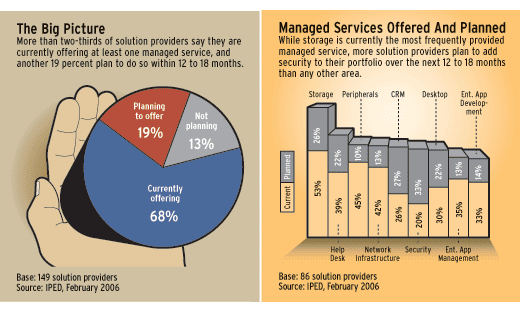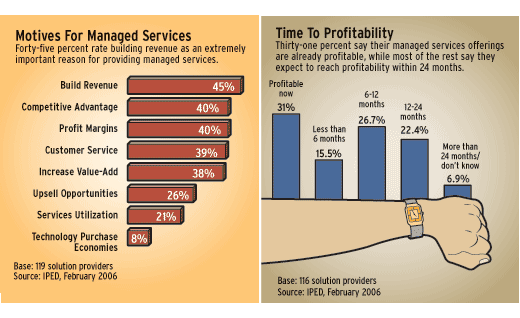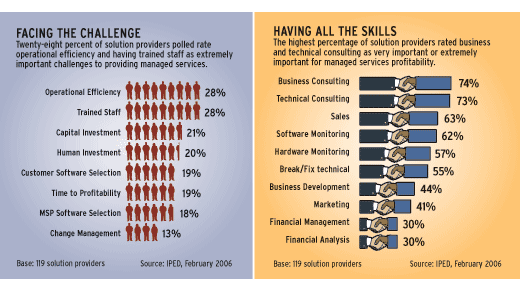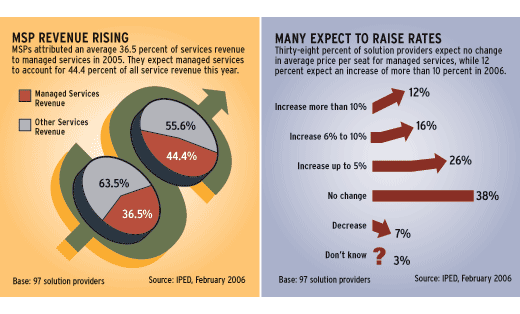In Search Of Managed Services
| /**/ /**/ |
Solution providers searching for a pathway to managed services may be closer than they think.
\
\
A new in-depth survey of 250 solution providers, conducted by the Institute for Partner Education & Development (IPED) and administered in partnership with
CRN
, revealed that MSP offerings evolve quite naturally from traditional solution provider business models.
\
\
In fact, the survey results challenge some common assumptions about how new MSP customers are transitioned, which managed services are most popular, how MSP services are performed and the importance of issues such as more flexible vendor financing.
\
\
IPED, a CMP Media channel consulting firm in Manhasset, N.Y., conducted the survey during the first quarter using this definition of managed services: Managed services are recurring services provided either on-site or remotely on a contractual basis. Based on that guidance, a whopping two-thirds of respondents said they already were providing some form of managed services. Another 19 percent planned to move into managed services within the next 12 to 18 months. Only 13 percent said they had no plans to become an MSP.
\
\
Respondents offering managed services said MSP revenue already accounts for more than one-third of their total services revenue. That healthy number indicates that many solution providers have been offering managed services for a considerably longer period of time than the handful of years that the practice—and the term MSP—has been widely popularized, according to IPED.
\
\
“The data shows managed services have not only been around for a while, it shows this thing is already here and full-blown,” said Stanley Elbaum, director of research at IPED.
\
\
According to the survey, the top three incentives for becoming an MSP were traditional ones: building revenue, adding competitive advantage and increasing profit margins. The top three managed service areas offered by MSPs were storage, peripherals and network infrastructure, respectively. More than half the respondents said they offered managed storage.
\
\
At the bottom of the list was security. Only about 20 percent of respondents said they provided managed security, a figure far lower than the hype around managed security services would suggest. The survey, though, also showed security was likely to grow faster than all other areas, with 33 percent of respondents planning to add security to their managed services portfolios over the next 12 to 18 months.
\
\
The survey results also indicate that solution providers are spending more of their time and resources transitioning their existing customers to managed services than prospecting for new ones. And MSPs have a pretty good idea which customers are ready for managed services and which are not, according to IPED.
\
\

\
\
Respondents estimated about 44 percent of current customers were potential managed services customers, out of which 39 percent were already engaged in an MSP relationship. On average, nearly half the customers of those surveyed will still be holdouts for managed services by the end of 2007, and winning this group over will require a strong effort, respondents indicated. Still, solution providers expected their MSP revenue to grow to three times faster than other services revenue, the survey showed.
\
\
That so much effort goes into converting existing customers to managed services shatters popular myths peddled by many MSP platform vendors that managed services are a fast track to bringing new customers in from the cold, said Larry Baum, chairman and CEO of The Computer Center, an Ithaca, N.Y.-based solution provider who has been offering managed services for about two years.
\
\
Baum said the resources his company directs toward converting existing customers to managed services dwarfs the efforts it makes to bring in new customers. “Ninety percent of our marketing dollars go back to existing customers,” he said. “As far as trying to add new customers, we just run a Yellow Pages ad. That’s it.”
\
\
One reason for that is there’s a higher risk involved in becoming the MSP for a completely new customer. “New customers are other people’s networks, and you can inherit big problems,” he said.
\
\
The effect of a market where practically every MSP platform vendor preaches a different pricing gospel had a significant impact on the survey results. Like MSP vendors such as LPI Level Platforms, N-able Technologies and SilverBack Technologies that offer MSP platforms ranging widely in price from just tens of dollars to thousands of dollars, respondents reported price points that ranged from $10 per month per seat to thousands of dollars per month per seat.
\
\
Without even a blip of concentration at one particular price point, there was no average result from respondents when it came to the pricing of either on-site or remote managed services, the IPED survey found.
\
\

\
\
Some solution providers just wing it at first, applying their best judgment to initial MSP pricing, then adjusting up or down accordingly.
\
\
“We set a price based on what we know about a customer [and] then watch it—going back to [the customers], talking to them, making sure we were not getting killed and they weren’t getting killed,” said Steve Quigley, business development manager at Clear North Technologies, a solution provider in Eden Prairie, Minn., who began offering managed services about six months ago.
| /**/ /**/ |
Others peg initial MSP pricing to legacy services costs. Powersolution.com, an MSP in Ho-Ho-Kus, N.J., bases initial pricing on its traditional project-based billing rate, adding in extras for things such as monitoring. For example, if a small customer with one server, 10 PCs, a few switches and a firewall was paying about $2,000 a month, the solution provider breaks down that price across the device count. “We found that pricing for legacy service was right there, and when we added remote monitoring of the customer, that was additional revenue,” said David Dadian, CEO of the MSP.
\
\
The survey revealed that the average solution provider invests about 15 percent of revenue in managed services, and more then 90 percent of respondents said they expected to become profitable as an MSP by the end of 2006.
Further indication that MSP profitability is real came from the survey’s challenge to the popular assertion that new financing models from distributors and vendors were needed to support the shift of a solution provider’s revenue stream from project-based to accrual-based revenue.
While proactive technical training, post-sales support and sales training topped the list of vendor programs seen as very important to the success of an MSP, respondents said programs such as flexible financing and usage-based licensing were among the least important areas of vendor support.
Terrence Chalk, founder, chairman and CEO of Compulinx Managed Services, an MSP in White Plains, N.Y., which spent four years building its MSP infrastructure in-house and became profitable within a year, said dependency on a vendor or distributor to provide more flexible financing can be reduced if a solution provider focuses more on remote monitoring and maintenance of a customer network, as opposed to providing or installing MSP services on-site.
“You get a more flexible credit line when you are building a network for yourself, but it’s different when you are building one for your customer,” Chalk said. “We bought more equipment for our network to enable an MSP model than we bought for our managed services customers. And that equipment we are not reselling, but we really are. It’s really a utilization re-sell.”
The growth of managed services could shake up traditional IT buying patterns, though, aligning vendors more closely to MSPs and triggering further consolidation among vendors and perhaps even VARs, IPED’s Elbaum said. And as the decisions on what products and services are dealt to customers becomes more and more the domain of the MSP, vendors will need to act quickly to gain the favor of MSPs.

\
“As a vendor in 2006, you better be establishing relationships with MSPs that are influential,” Elbaum said. “Two years from now, you won’t have as good a chance.”
\
\
The remote monitoring features in popular MSP platforms have created a perception that being an MSP is a job performed remotely. However, survey respondents said their 2006 MSP revenue would be nearly equally split between on-site (52 percent) and off-site (48 percent).
\
\
Elbaum cited the hefty on-site MSP revenue as further evidence that managed services have been practiced by solution providers long before the popular MSP platforms brought managed services into vogue. “If you look at the chronology of managed services, the on-site part likely came first,” he said.
\
\
On-site vs. off-site service is a good place to begin to define what an MSP really is, said Derek Smith, vice president of corporate development at TecServ, a $4 million-per-year solution provider and MSP in Salt Lake City, which has seen a 100 percent growth in its remote managed services contracts in just the last year. “If you have on-site services, that’s not MSP, that’s outsourcing,” he said.

\
More than half the respondents to the survey (54 percent) said they expect to see the average price point for their managed services increase in 2006. And while a small percentage said price increases could be as high as 10 percent, the average price increase expected was about 3 percent. Only 7 percent of respondents expected to see a decrease in MSP pricing in 2006, and more than one-third of all respondents said they anticipated no change in price at all.
\
\
The education and commitment required to shift from project-based work to proactive managed services was at the forefront for solution providers adding managed services. Of the business processes solution providers transformed during their change into MSPs, proactive technical training, managing transition and pre- and post-sales support all ranked high with a majority of respondents.
\
\
Michael Cooch, CEO of Everon Technology Services, a Boston-based MSP that does business 100 percent remotely, said VARs and customers alike should be fully committed to managed services before embarking on the road.
\
\
“There is a sense of commitment that makes it successful,” Cooch said.